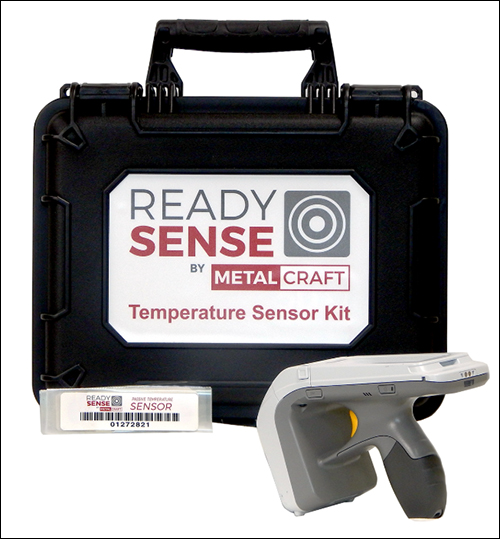While temperature-sensing, passive RFID-based solutions have been available for several years, adoption is often limited or delayed due to the cost of piloting the technology. Many companies have a unique use case for temperature-sensing tags, but they lack readers and software in place to test their theories. Metalcraft has released what it hopes will be a solution for manufacturers, cold-chain suppliers and emergency medical providers, in the form of a test kit that puts a passive UHF RFID temperature-sensing system in the hands of such firms so that they can begin experimenting.
Metalcraft’s Temperature Sensor Kit, designed as a low-cost passive RIFD sensing solution for systems integrators and end users, enables companies to deploy disposable UHF RFID sensing labels that transmit temperature data when interrogated. The kit consists of a Zebra Technologies RFD8500 handheld sled reader with a USB charging cable, 25 Metalcraft UHF RFID temperature sensor tags and the company’s ReadySense mobile temperature app that works with iOS- or Android-based devices. The kit was released in conjunction with this year’s RFID Journal LIVE! conference, held this month in Phoenix, Ariz. Contacts made at the event have led to sales of the kits to end users, as well as potentially to systems integrators.
The solution is designed to prove whether or not UHF RFID technology can be deployed in whatever specific use case a company is considering, after which that company can acquire a full solution that could include fixed and handheld readers, as well as cloud-based software and an app. The kit is not designed to provide on-metal tracking or monitor the skin temperature of a patient in a health-care environment.
ReadySense temperature sensor tags are passive devices that can detect and monitor temperature levels, whether on plastic, wood or other non-metal surfaces. A EM Microelectronic 4325 chip built into the tag detects any changes in voltage across a diode, then transmits that event to the reader when interrogated, enabling the app to calculate temperature changes. With a handheld reader, the ReadySense tags have a read range of approximately 15 to 22 feet, says Austin Elling, Metalcraft’s marketing director.
The latest version of the label can also accommodate batteries for use with battery-assisted tags that could enable data-logging (collecting temperatures periodically and storing that data until a tag is read), while also enabling a longer read range. However, the kit includes the passive labels only. After buying the kit—at a price of $2,495 with unlimited, lifetime use of the app—a user can simply download the app on his or her phone and attach that phone to the RFD8500 sled reader. The tags come with a pressure-sensitive adhesive so they can be attached to cartons of fresh produce or other goods, allowing users to begin reading tags and taking temperature readings.
“We’ve offered sensor tags for a while,” Elling says. “What we found was [that] we had a lot of interest in them, but basically a lot of companies wouldn’t know how the system would work in their environment.” That made an RFID system a hard sell, he notes, for companies that needed financial support from management for an untried solution. “They needed the data, some testing, some sample applications to say ‘Yes, this looks like it will work, now we can move forward to a larger project.'”
There are a wide variety of use cases, according to Jared Doerfler, Metalcraft’s sales manager. But initially, he says, they tend to fall into three categories: cold chain management, emergency medical services and manufacturing. For cold chains, the kit can help users track the temperatures of products moving through distribution centers or warehouses, as well as when they are in transit. And for emergency medical services, the technology is being tested on fleets of ambulances to track the temperatures around some assets used to treat patients.
In manufacturing, companies want to ensure that their products are in the best environment, even before they leave a factory. For instance, one manufacturer is using the kit to track the temperatures of goods as they are stored, palletized and shipped from its facility. In this use case, Elling says, companies typically wish to have data that confirms temperatures never exceed specified parameters, and to collect that information automatically, rather than using a manual method of tracking temperatures. The system also works in the agriculture sphere, Doerfler says, for managing the conditions around food or feed as goods are harvested, stored, chilled or shipped.
“I think the kit will accomplish two things,” Elling predicts. For one thing, he says, it will enable companies to start automating temperature-sensing as part of their manufacturing or supply chain processes. What’s more, he adds, “I think you’ll see a wider adoption of [RFID] for the transparency of sensor data related to goods or assets.” That means businesses will be able to share their data with others in their supply chain, or with customers who will be purchasing products.
That greater visibility of data, Doerfler says, will be meaningful for multiple parties as temperature data is being automatically collected. “It will allow our partners and customers to make better decisions that will positively impact everyone involved,” he explains. In the meantime, companies continue to bring new use cases to Metalcraft, some of which may not be feasible, though others might be. “It’s interesting to see what comes in,” Elling states. “There’s a market out there… We believe this is a great kit to get companies going” with RFID.


